new posts in all blogs
Viewing: Blog Posts Tagged with: Sophies Squash, Most Recent at Top [Help]
Results 1 - 5 of 5
How to use this Page
You are viewing the most recent posts tagged with the words: Sophies Squash in the JacketFlap blog reader. What is a tag? Think of a tag as a keyword or category label. Tags can both help you find posts on JacketFlap.com as well as provide an easy way for you to "remember" and classify posts for later recall. Try adding a tag yourself by clicking "Add a tag" below a post's header. Scroll down through the list of Recent Posts in the left column and click on a post title that sounds interesting. You can view all posts from a specific blog by clicking the Blog name in the right column, or you can click a 'More Posts from this Blog' link in any individual post.
Pat Zietlow Miller is the author of the award-winning (and adorable!) picture book Sophie's Squash, illustrated by Anne Wilsdorf. Sophie's Squash is story that celebrates the special love between a child and her favorite toy--only in this case it's a butternut squash. On a trip to the farmers' market with her parents, Sophie chooses a squash, but instead of letting her mom cook it, she names it Bernice. Sophie's Squash has earned many accolades and honors, including four starred reviews, the Golden Kite Award, the Charlotte Zolotow Honor Book Award, and the Ezra Jack Keats Honor Book Award.
 And fortunately for the children's book world, Pat has more books coming out in the world--SEVEN to be exact (at last count). Coming in April is Wherever You Go, illustrated by Eliza Wheeler. In Wherever You Go, join an adventurous rabbit and his animal friends as they journey over steep mountain peaks, through bustling cityscapes, and down long, winding roads to discover the magical worlds that await them just outside their doors. This book celebrates the possibilities that lie beyond the next bend in the road – the same road that will always lead you home again. Kirkus Reviews gave Wherever You Go a starred review with the praise: "Miller's verse, infused with musical momentum, communicates the emotional arch of a journey with beautiful brevity."
And fortunately for the children's book world, Pat has more books coming out in the world--SEVEN to be exact (at last count). Coming in April is Wherever You Go, illustrated by Eliza Wheeler. In Wherever You Go, join an adventurous rabbit and his animal friends as they journey over steep mountain peaks, through bustling cityscapes, and down long, winding roads to discover the magical worlds that await them just outside their doors. This book celebrates the possibilities that lie beyond the next bend in the road – the same road that will always lead you home again. Kirkus Reviews gave Wherever You Go a starred review with the praise: "Miller's verse, infused with musical momentum, communicates the emotional arch of a journey with beautiful brevity."
To learn more about Pat Zietlow Miller, visit her website.
Describe your workspace.
I write in one of two spots. At my kitchen table surrounded by the detritus of life in a family of four – books, papers, pens, calendars, mail, dishes – or at a desk upstairs that looks much more writerly. I’m probably in the kitchen more often just because that’s the way things seem to work out.
Describe a typical workday.
Most days, I’m at my regular job in corporate communications at an insurance company editing copy and writing about auto, home, and life insurance. (Hint: Having umbrella coverage is a good idea.)
When I get home, I start dinner, talk to my husband and kids, and help with homework where I can. English and language arts are fine. Calculus and physics are not. Then, when the kids are studying and my husband is watching basketball, I flip open my laptop and get going. Of course if the kids have evening activities, I’m probably driving them there instead of writing.
So when I do write, I tend to be pretty focused. I don’t have a lot of time to mess around.
List three of your most favorite things in your workspace and why they are meaningful.
These are all from my upstairs formal writing space.
- A dictionary and bookmark I got from my high school English teacher Gladys Veidemanis after I was voted “Most Likely to Be Published” by my classmates. It took more than 20 years after I graduated, but it did happen.
- A nameplate that belonged to my aunt, Faye Clow, who was director of the Bettendorf Public Library for many years. She was a huge proponent of books and literacy, and I always loved her and admired that. My upcoming book, Sophie's Seeds (Schwartz & Wade, 2016), is dedicated to Faye.
- The F&G [publishing term that means folded and gathered--they are fancy colored proofs] of whatever my next book is. Right now, I have Wherever You Go, which is coming from Little, Brown on April 21 and Sharing the Bread, which is coming from Schwartz & Wade on Aug. 25. Getting the F&Gs always makes the book finally seem real.
Do you have any rituals in your work habits? If so, describe them.
Open lap top. Sit down. Start typing.
Ignore any tears, arguments, or requests for help finding lost items until the young person involved either goes away or asks my husband. While some writers follow very organized processes when writing, I’m a little more haphazard. I wrote a post about this for Tara Lazar’s Picture Book Idea Month.
What do you listen to while you work?
Everything listed in my answer to the previous question. I really prefer not to have music playing while I write. It impedes my ability to focus on the story. (When you read my answer to the next-to-last question, you’ll see that this can be a problem.)
What is your drink and/or snack of choice while you’re working?
I normally don’t eat or drink while I’m writing. I tend to eat and drink when I get up and walk around because I’m temporarily stuck. Then, dark chocolate is always good. But I have standards. It’s got to be top-of-the-line stuff.
What keeps you focused while you’re working?
Getting the story done and making it the best it can possibly be. Finding the perfect combination of words is really important to me. And I love critique partners and editors who really challenge me if they think I haven’t quite done it.
Do you write longhand, on a computer, or another way?
Nearly always on a computer. Very rarely, I’ll write longhand if I’m on a plane or a bus and a pad of paper is all I’ve got to work with. But I do jot down notes longhand, usually phrases that I think sound intriguing.
How do you develop your story ideas? Do you use an outline, let the muse lead you, or another technique?
It sounds terribly boring, but I’m afraid I just sit down, open my laptop and start writing. Sometimes, I stare at my manuscript for a while before starting. While I certainly have been inspired, I don’t really believe in waiting for inspiration, because I could be waiting a long time. I find that the mere act of beginning to write usually kick-starts my inspiration.
If you were forced to share your workspace but could share it with anyone of your choosing, who would it be?
My husband. He’s a sportswriter and works out of our house. On days that I’m not at my day job, we often work in adjoining rooms. He’s fun to have around, although he sometimes plays really, really bad music while he works – like “My Girl Bill.” If we ever worked next to each other long term, this could become problematic.
What is the best piece of writing advice you’ve heard or received?
<!--[if gte mso 9]>
Normal 0 false false false EN-US JA X-NONE <![endif]-->
It’s what I learned in a high school journalism class taught by Ron Harrell. The end of your story has to have some element of the beginning in it to provide satisfying closure. He said it was like wrapping a ribbon around a present and tying a big bow. I wrote a blog post about this concept on Picture Book Builders.

 by Pat Zietlow Miller
by Pat Zietlow Miller
“What process do you follow to write your stories?” I’ve heard that question more frequently as I’ve sold more picture books, and I never know how to answer.
The people asking usually look as if they’re waiting for a golden ticket to inspiration. Like maybe I’ll say that I always walk three times around my living room, stand on one foot, hum the “Star-Spangled Banner” and then run to the computer to start writing before the muse I’ve conjured flies away. Then, they can do the same thing and wait for their own inspiration to strike.
When I tell the truth—that I don’t have a specific writing process—they seem disappointed. But, trust me. I’m doing them a favor. If they knew how things really go down, they might give up writing altogether. I’m a little haphazard.
But, just for you, in honor of PiBoWriMo, I am pulling back the curtain and sharing my process, such as it is. Here’s how I wrote WIDE-AWAKE BEAR, which is coming from HarperCollins in 2017:
Step One:
Have a cranky child.
Three years ago, my youngest daughter was happily napping on the couch. When I woke her to take her to volleyball practice, she had a world-class meltdown. There was wailing, tears and shouting. I tossed her into the car and took her anyway. Afterward, when she was calm, I said, “What was THAT all about?” Her response? “I was a hibernating bear. You woke me up, and I went into a bear frenzy.” (Author’s note: Is that not the best response ever? I love this kid.)
Step Two:
Forget about that adorable incident.
I filed that wonderful remark under the category of “Cool Stuff My Kid Has Said” and went about my business. For several years.
Step Three:
Be bored on a plane.
On a plane ride home from Yellowstone Park, where I was disappointed I hadn’t seen a bear, I thought I should use the flying time to do something productive. So I grabbed a notepad and pen and wrote a story about a bear cub who wakes up in the middle of winter and goes into a bear frenzy.
Step Four:
Listen to your critique group say, “Meh.”
I shared this story with my critique group and got a lukewarm response. They thought the bear cub got too cranky and deserved a timeout. They also didn’t understand why he got so angry. So I adjusted and reworked the story over several weeks. The title changed, and the storyline morphed into a bear cub who woke up midwinter, got scared and couldn’t fall back asleep. I shared it with some more writing friends and adjusted it even more. Then, I stopped, because I didn’t know what else to do.
Step Five:
Let it sit on your desktop for a while.
I wasn’t sure the story was ready. So I worked on other things and didn’t think much about it.
Step Six:
Send it to your agent on a whim.
Then one day, I opened the file and thought, “This isn’t so bad.” (See how I just glow with self-confidence?) I sent it to my agent, hoping she might give me a few ideas so I could work on it some more. But she thought it was ready to go, sent it out and it sold in about three weeks. That’s my quickest sale ever.
So, there you have it. How to write and sell a picture book in six simple steps. You know just what to do now, right?
I told another writer about my lack of a process, and she said, “You do have a process. It’s organic!” And she is absolutely right, because I’ve never once used pesticides in any of my books.
If there’s anything to learn from my post, it’s that everyone’s process is different. As long as you find something that works for you, you’ll be fine. If you’re not seeing the results you want and feel like your process may be fault, try a few different things.
- Be haphazard—I mean organic—like me.
- Be super-organized like another writer I know who sets her timer for 45-minute chunks and logs her writing time on a chart posted on her office door.
- Try writing mornings or evenings to see if something works better. Try different locations, too.
- Try standing on one foot in your living room and humming the national anthem. (It could work.)
Chances are something will seem more appealing to you and you’ll be well on your way to finding your own inspiration.

To learn more about me, visit PatZietlowMiller.com or follow me on Twitter at @PatZMiller.

If you leave a comment on this post you could be one of two people to win one of two prizes—a signed copy of SOPHIE’S SQUASH (Schwartz & Wade, 2013) to be sent immediately or a signed copy of WHEREVER YOU GO to be sent once it’s released from Little, Brown on May 5, 2015. Each of these books followed a totally different process than WIDE-AWAKE BEAR. I meant it when I said my process was haphazard.
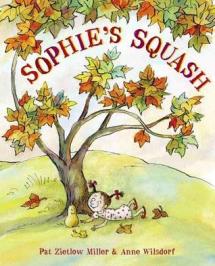
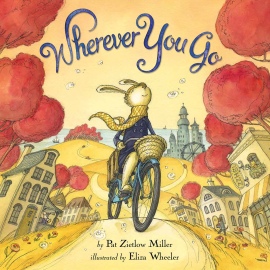
This prize will be given away at the conclusion of PiBoIdMo. You are eligible for this prize if:
- You have registered for PiBoIdMo.
- You have commented ONCE ONLY on today’s post.
- You have completed the PiBoIdMo challenge. (You will have to sign the PiBoIdMo Pledge at the end of the event.)
Good luck, everyone!


Here’s a book I thought I’d blogged about before, but it seems I only mentioned it briefly.
by Pat Zietlow Miller, illustrated by Anne Wilsdorf.
We first read this absolute gem of a picture book last year during the CYBILs. Fell so utterly in love with it—the lot of us—that a library copy wouldn’t do; we had to have our own. Huck and Rilla were overjoyed when I pulled it out this morning. Sophie’s instant bond with a butternut squash is utterly believable, and not just because Huck formed a similar attachment once upon a time. “Bernice” becomes Sophie’s best friend and closest confidant, all through a bright and beautiful autumn. But as winter approaches, Bernice begins to get a bit squishy about the edges. Sophie’s parents make gentle attempts to convince Sophie it’s time to let her friend go, but since their suggestions involve treating the squash like, you know, a squash, Sophie’s having none of it. Her own solution is sweet and heartwarming, and it makes my kids sigh that contented sigh that means everything has come out exactly right.
 by Pat Zietlow Miller
by Pat Zietlow Miller
I’ve heard some authors talk about how they are inspired to write their stories.
They say their characters talk to them. They have whole conversations with those characters, interviewing them about their name, background, problems and motives.
They also share stories of times these characters high-jacked the story, taking it in an entirely different direction than the author planned. Sometimes that works out, and other times the authors have had to cut uncooperative characters to get their story back on track.
I think that all sounds awesome.
But it’s never happened to me.
I’ve also talked to authors who see pictures in their heads. Their stories unfold in their brains like a movie on the screen.
That’s also very cool.
But it’s never happened to me either.
So where do I get my inspiration?
Ideas for my picture books usually come one of two ways:
1. Snippets of words.
My two upcoming rhyming picture books started when I was busy at my day job and some words popped into my head.
For SHARING THE BREAD: AN OLD-FASHIONED THANKSGIVING STORY (coming in 2015 from Schwartz & Wade), the words I heard were “Mama be a cooking pot, cooking pot.” That was it. I think my initial reaction was “What?”
For WHEREVER YOU GO (coming in 2015 from Little, Brown) I heard “Over a hill, under a bridge, deep in a dale, high on a ridge.” And I had a very similar reaction. “What am I supposed to do with this?”
In both cases, I wrote the words down and emailed them to myself at home where they sat for quite a while. Then, I started playing with them. And working. Because the rest of the books did NOT just pop into my head.
I had no idea SHARING THE BREAD was going to end up as a Thanksgiving story—and it didn’t become that until a late revision. And, I had no idea WHEREVER YOU GO would end up being a story about how the choices we make determine our destination.
But those lines got me writing, which was inspiration enough. And I’ll always be grateful for whatever made them dance through my head.
2. Admiration.
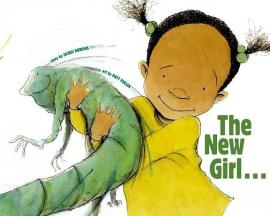 Sometimes, I read a picture book I just adore. One that makes me stare in awe and wish I could produce something even remotely close to its perfection.
Sometimes, I read a picture book I just adore. One that makes me stare in awe and wish I could produce something even remotely close to its perfection.
And often, I’ll try to do just that. I’m not trying to copy the book I love. But I am trying to capture some part of its essence in another form. THE QUICKEST KID IN CLARKSVILLE (coming from Chronicle) came about after I read Jacqui Robbins’ and Matt Phelan’s THE NEW GIRL… AND ME.
The final books are nothing alike. Jacqui and Matt’s is a modern-day story about a new girl at school who owns an iguana. Mine is set in 1960 and features two girls who idolize Olympic sprinter Wilma Rudolph. But I was inspired by the way Jacqui captured friendship in her book and wanted to see if I could do something similar.
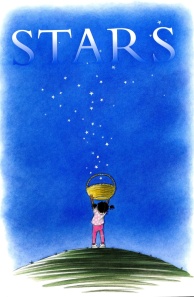 And WHEREVER YOU GO’s style was inspired by the lyricism of Mary Lyn Ray’s and Marla Frazee’s so-wonderful-I-can’t-even-stand-it picture book, STARS.
And WHEREVER YOU GO’s style was inspired by the lyricism of Mary Lyn Ray’s and Marla Frazee’s so-wonderful-I-can’t-even-stand-it picture book, STARS.
When I fall in love with a picture book, I’ll spend a lot of time reading and re-reading it. First for fun, then for structure, then for language and plot and pacing and page turns. I may even buy an extra copy to write on. All this soaks into my head and helps my future picture books be better.
It’s kind of like golfers studying a professional’s swing by playing the video in freeze frames and slow motion so they can see every last movement.
I also have to mention my current picture book SOPHIE’S SQUASH (Schwartz & Wade, 2013). It was inspired by a few extremely cute things my daughter did. Then, I added a bunch of stuff that never happened to turn a cute moment into a fully realized story.
Both my methods of inspiration have one thing in common. There’s something that I hear or see that captivates me enough where I want to put in the work to come up with something wonderful of my own.
But I’m going to keep listening for my characters, just in case they decide to get chatty.

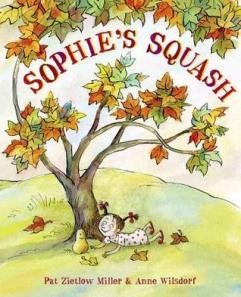
Pat started out as a newspaper reporter and wrote about everything from dartball and deer-hunting to diets and decoupage. Then, she joined an insurance company and edited its newsletter and magazine.
Now, she writes insurance information by day and children’s books by night. Her newest release is SOPHIE’S SQUASH, illustrated by Anne Wilsdorf.
Pat has one wonderful husband, two delightful daughters and two pampered cats. She doesn’t watch much TV, but she does love “Glee” and “Chopped.”
You can learn more about Pat by visiting her website at PatZietlowMiller.com or following her on Twitter at @PatZMiller.



By:
Jen Robinson,
on 10/10/2013
Blog:
Jen Robinson
(
Login to Add to MyJacketFlap)
JacketFlap tags:
sophie's squash,
Reviews,
picture book,
friendship,
Picture Books,
fall,
random house,
Newsletter,
anne wilsdorf,
pat zietlow miller,
Add a tag
Book: Sophie's Squash
Author: Pat Zietlow Miller (@PatZMiller)
Illustrator: Anne Wilsdorf
Pages: 40
Age Range: 3-7

 Sophie's Squash is a picture book by Pat Zietlow Miller about loyalty, presented in a quirky, entertaining manner. When Sophie's chooses a squash at the farmer's market one late fall, her parents expect that the squash will become dinner. They do not expect that the squash will become Sophie's new best friend. But Sophie has other ideas.
Sophie's Squash is a picture book by Pat Zietlow Miller about loyalty, presented in a quirky, entertaining manner. When Sophie's chooses a squash at the farmer's market one late fall, her parents expect that the squash will become dinner. They do not expect that the squash will become Sophie's new best friend. But Sophie has other ideas.
This is all told totally deadpan. Like this:
"When it was time to make supper, Sophie's mother looked at the squash. She looked at Sophie." (The squash has a marker-drawn face at this point)
"I call her Bernice," Sophie said.
"I'll call for a pizza," said her mother.
Despite her parents' best efforts to interest her in other toys, despite the mockery of other children, Sophie remains loyal to Bernice. And when Bernice, inevitably, starts to rot, Sophie comes up with a perfect solution (on her own, I might add). Not to worry - love triumphs over all.
I like the wry reactions of Sophie's parents:
"Well, we did hope she'd love vegetables," Sophie's mother told her father.
And I love Sophie's loyalty, her deafness to criticism. After some kids point and stare during a library visit, Sophie's mom suggests that she stay home next time. Sophie asks: "Why? She wasn't the one being rude." Indeed.
This book has a similar plot line to The Wheat Doll by Alison Randall,reviewed here. It has the same warmth, but a much lighter, more humorous tone. Sophie's Squash would also pair well with Bob Staake's Mary Had A Little Lamp, reviewed here.
Anne Wilsdorf's watercolor and ink illustrations are perfect for the story. Bernice is, well, a squash with a face, but she looks lovable. Sophie is frequently belligerent-looking, with annoyed eyebrows, and pigtails that stick up in the air. She's the tiniest bit cartoonish, but her home is cozy and ordinary. And her joy, at the end of the book, simply glows from the page.
Sophie's Squash conveys a strong message about loyalty and love, but the message is delivered completely within the context of the story. Sophie is a solid character, one who kids will be able to relate to (boys or girls). While Sophie's Squash, with its foliage-strewn cover, is a natural fit for fall, I expect it to be read year-round in my household. [In fact, I was scarcely able to review it, because my three-year-old, after asking me to stop mid-review to read it to her, wanted to take the book with her when she left. I had to promise to read it again later.] Highly recommended.
Publisher: Schwartz & Wade (@RandomHouseKids)
Publication Date: August 6, 2013
Source of Book: Review copy from the publisher
FTC Required Disclosure:
This site is an Amazon affiliate, and purchases made through Amazon links (including linked book covers) may result in my receiving a small commission (at no additional cost to you).
© 2013 by Jennifer Robinson of Jen Robinson's Book Page. All rights reserved. You can also follow me @JensBookPage or at my Growing Bookworms page on Facebook.

 And fortunately for the children's book world, Pat has more books coming out in the world--SEVEN to be exact (at last count). Coming in April is Wherever You Go, illustrated by Eliza Wheeler. In Wherever You Go, join an adventurous rabbit and his animal friends as they journey over steep mountain peaks, through bustling cityscapes, and down long, winding roads to discover the magical worlds that await them just outside their doors. This book celebrates the possibilities that lie beyond the next bend in the road – the same road that will always lead you home again. Kirkus Reviews gave Wherever You Go a starred review with the praise: "Miller's verse, infused with musical momentum, communicates the emotional arch of a journey with beautiful brevity."
And fortunately for the children's book world, Pat has more books coming out in the world--SEVEN to be exact (at last count). Coming in April is Wherever You Go, illustrated by Eliza Wheeler. In Wherever You Go, join an adventurous rabbit and his animal friends as they journey over steep mountain peaks, through bustling cityscapes, and down long, winding roads to discover the magical worlds that await them just outside their doors. This book celebrates the possibilities that lie beyond the next bend in the road – the same road that will always lead you home again. Kirkus Reviews gave Wherever You Go a starred review with the praise: "Miller's verse, infused with musical momentum, communicates the emotional arch of a journey with beautiful brevity."





 by
by 



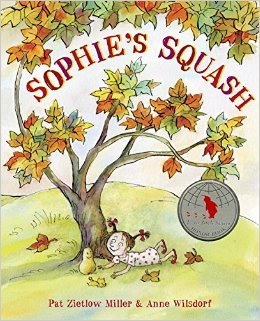
 by
by  Sometimes, I read a picture book I just adore. One that makes me stare in awe and wish I could produce something even remotely close to its perfection.
Sometimes, I read a picture book I just adore. One that makes me stare in awe and wish I could produce something even remotely close to its perfection. And WHEREVER YOU GO’s style was inspired by the lyricism of Mary Lyn Ray’s and Marla Frazee’s so-wonderful-I-can’t-even-stand-it picture book, STARS.
And WHEREVER YOU GO’s style was inspired by the lyricism of Mary Lyn Ray’s and Marla Frazee’s so-wonderful-I-can’t-even-stand-it picture book, STARS.


Love her simple approach! I’m in a “frenzy” about it! 😃
The message I keep hearing is collect all those life snipetts because you never know were they might lead you. Thanks!
Pat, your post is entertaining. Just like your books.
My process is similar, except for having the agent to send it to.
Dear Pat, Thank you for some valuable insight. One of my takeaways is :in spite of the critiques- go with your gut. Thanks for that and more!
Dear Pat,
Your article of a glimpse into your writing personality for Tara & us is totally not “meh.” I have long luvved that word because it makes me work harder.
I think the push-me, pull-me directions here are the bear’s bacon. Brava!
And very un-meh kudos for your picrure books!
j a n
Jan Godown Annino
@BkSeedStudio
Thank you, Pat! Your posting helps me believe in myself.
You have to believe.
Thank you Pat, Whats the title of your bear book, id love to read it!
I love your sense of humor Pat! Your process may be organic, but your eye and ear for the sublimely wonderful and funny are also spot-on!